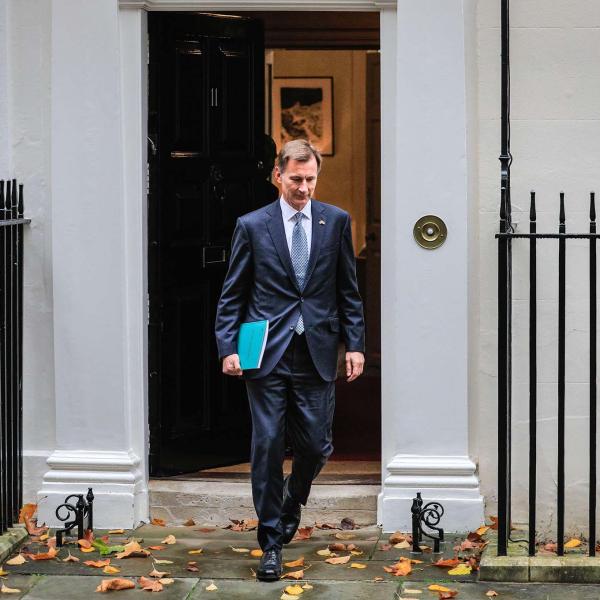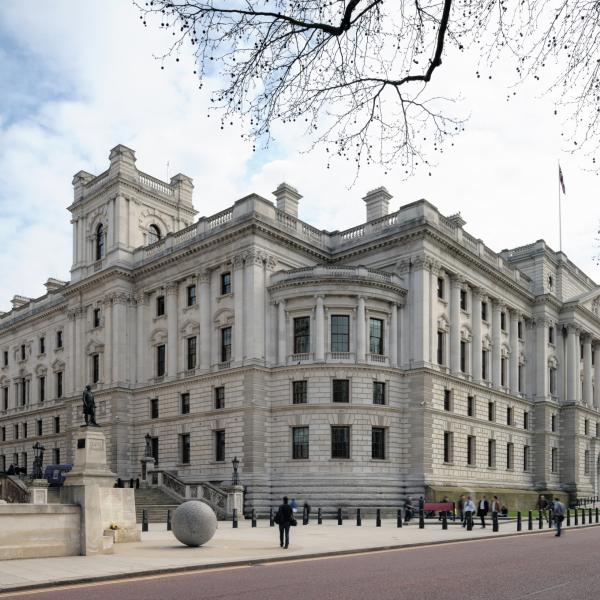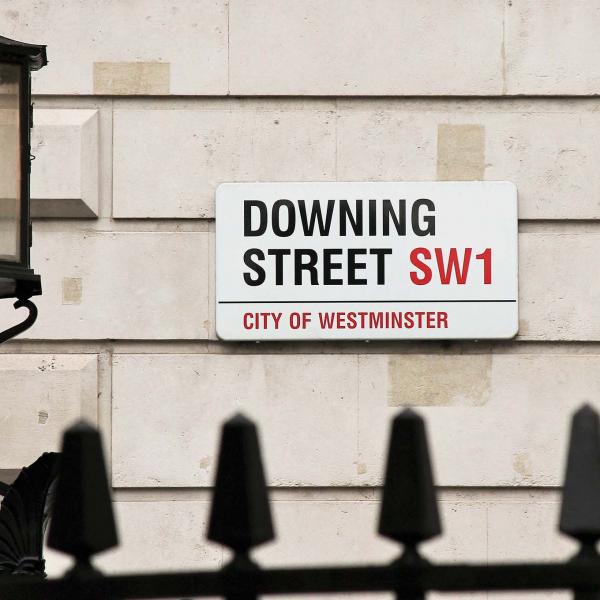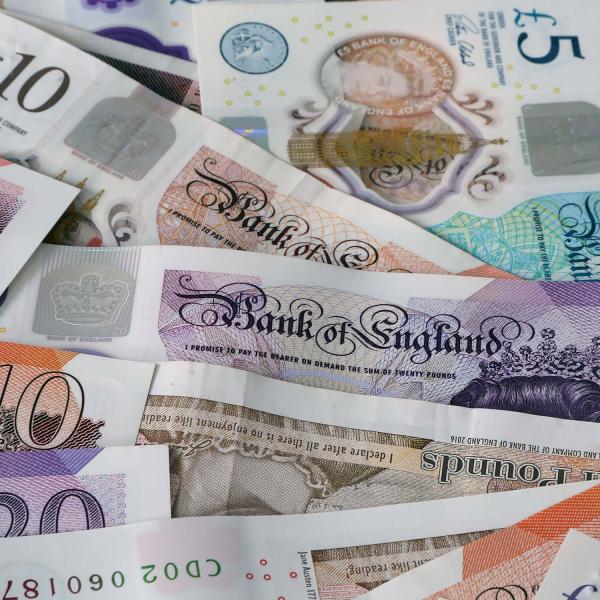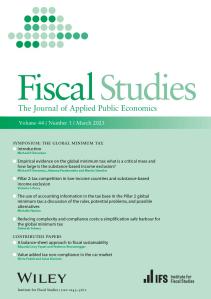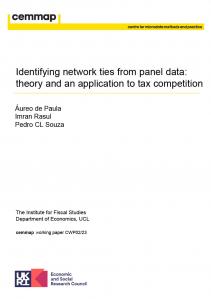In October most large companies (those with previous annual profits of over £1.5m) made the third of four instalments due in 2011-12 for their corporation tax. Oil and gas firms paid one of their three instalments. In March this year the Office for Budget Responsibility (OBR) forecast that corporate tax receipts for the current financial year would increase by 14.2%. Figures released today show that over the first seven months of this financial year corporate tax receipts were running 0.7% below the same period last year. In October receipts actually fell by 6.9%, compared to the same month last year, with the OBR attributing this to financial sector firms being adversely "affected by weaker investment banking activity, writedowns on euro area sovereign debt and provisions for the mis-selling of payment protection insurance" and a steep fall in gas and oil production, partly as a result of increased maintenance and temporary shutdown of fields.
Corporate tax raises significant revenues - around £43 billion, or 8% of total revenue in 2010-11. Corporate tax revenues (in cash terms) peaked in 2007-8, and fell in each of the two following years. Corporate tax receipts from North Sea oil companies fell particularly sharply. This trend was reversed in 2010-11 when corporate tax receipts increased by 18%. The strongest growth came from the financial services and North Sea sectors.
Corporation Tax net receipts, by sector, 2000-01 to 2010-11 (£ billions)
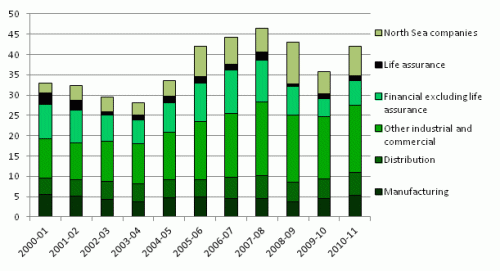
Source: HMRC, Table 11.1
The financial services sector has tended to be a large contributor to UK corporate tax receipts. Revenues from this sector, as well as from North Sea companies, are among the more volatile. Going forward there are a number of uncertainties related to amount of revenue the government will raise from the financial sector. There is uncertainty about the future level of financial sector profits and whether they will remain in the UK. There is also some uncertainty over how the sector will be taxed going forward (the government introduced a Bank Levy in January this year and there are calls from, among others, the European Commission to introduce a so called 'Tobin Tax' on financial transactions).In its latest medium term forecast the OBR set out that the share of total receipts from the financial sector (including PAYE, NICs and corporation tax) is not expected to return to the 2007-08 peak by the end of the forecast period in 2015-16 (see Box 4.1)
Who pays tax?
First, it is important to remember that ultimately companies don't pay tax, people do. The actual incidence of corporate tax is borne either by the owners of capital (in the form of lower investment returns), by workers (in the form of lower wages) or by consumers (in the form of higher prices). Of these groups, capital tends to be the most mobile. As a result corporate tax tends to get shifted to workers or consumers - and especially workers - but with a larger distortionary effect than if these groups had been taxed directly. This is especially important in discussions about companies paying their 'fair share'. With this in mind, we discuss how tax payments vary across companies.
As you would expect, the large companies that earn the majority of profit also pay the largest amount of tax. In 2007-08 the largest 1% of companies (by taxable profit) accounted for around 80% of corporate tax receipts. Many small and medium companies pay no tax at all, either because the make no profits or because they have losses that can be carried forward and offset against tax liabilities. We also expect that as profit increases, the proportion of profit paid in tax will increase. This is because allowances, which act to reduce tax liability, become much less important at higher income levels.
Recent work by the Oxford Centre for Business Taxation provides a detailed analysis of the amount of tax UK firms pay as a percentage of their profits. This varies across companies depending on a large number of factors. They find that most large companies, and those within multinational groups, pay on average a higher proportion of their income in corporate tax. However, there are a small group of the very largest companies that appear to pay little or no tax in the UK.
Tackling tax avoiders?
Tax avoidance has attracted increasing attention in recent years, with a number of groups calling for government action to increase the amount of tax we collect from companies.
There are a range of ways in which firms seek to minimise their tax bill. We expect most firms to take full advantage of allowances and provisions in the tax code - no one expects companies voluntarily to pay more tax than is necessary. Some firms may be more aggressive in their tax planning and seek to exploit loopholes or favourable interpretations of uncertainty in tax legislation. While this activity is legal, many would argue that it is not in the spirit of the law. However, these activities are distinct from tax evasion, in which firms illegally manipulate their tax liability.
The precise characterisation of what counts as tax avoidance is subject to much debate and has many grey areas. The OECD defines tax avoidance as 'the arrangement of a taxpayer's affairs that is intended to reduce his tax liability and (...) is usually in contradiction with the intent of the law it purports to follow'. Of course, not all parties will interpret the 'intent of the law' in the same way. These issues and the possible ways in which the UK government could seek to address avoidance are reviewed in a recent Tax Law Review Committee paper.
We do not have precise measures of which firms are avoiding tax or by how much. The tax gap - the difference between the amount of tax that firms 'should' and actually do pay - is not only hard to define conceptually but is extremely difficult to estimate accurately. Clearly, this difficulty arises largely from the need to determine the correct amount of tax a company owes.
HM Revenue and Customs have produced an analysis on the UK tax gap, noting the many impediments to the exercise. The estimated corporation tax gap was £6.9 billion in 2008-09, which represented 14% of the overall gap - i.e. 14% of difference between total theoretical liabilities and all collected tax receipts.
The government are taking a number of steps to reduce tax avoidance, including considering the possibility of introducing a General Anti-Avoidance Rule (GAAR) - a broad set of principle-based rules designed to prevent tax avoidance. A report commissioned by the Government to consider the merits of a GAAR, and published yesterday concluded that "a moderate rule which does not apply to responsible tax planning, and is instead targeted at abusive arrangements, would be beneficial for the UK tax system" and that the focus should be on "abnormal" practices. But a grey area between what is normal and what is abnormal might be difficult to avoid.

